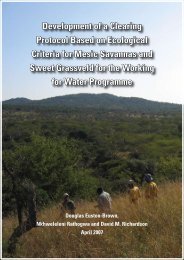INFORMATION DOCUMENT - DWA Home Page
INFORMATION DOCUMENT - DWA Home Page
INFORMATION DOCUMENT - DWA Home Page
Create successful ePaper yourself
Turn your PDF publications into a flip-book with our unique Google optimized e-Paper software.
PUBLIC DISCLOSURE<br />
AND INVOLVEMENT<br />
Public disclosure and input into<br />
policy development is the policy<br />
of the LHDA and a World Bank<br />
requirement. It involves the use of<br />
two-way communication:<br />
❏ May-June 2002: a pilot<br />
consultation process was<br />
conducted, in 16 potentially<br />
affected villages downstream of<br />
Phase 1 structures in a 5 km wide<br />
corridor each side of the river<br />
❏ May-August: meetings with the<br />
Principal Chiefs of Lesotho are an<br />
important matter of protocol<br />
❏ June-August: extension of this<br />
process to all downstream villages<br />
in potentially significantly affected<br />
river reaches in a 5 km wide<br />
corridor each side of the river (IFR<br />
Sites 1, 2, 3 and 7)<br />
❏ Public disclosure: this document<br />
represents the first step in a<br />
process which will inform the<br />
broader interested and/or affected<br />
community about the IFR policy<br />
❏ Public consultation: the posting<br />
of the Draft IFR Policy on websites<br />
and in libraries, in early August<br />
2002 for 30 days, for the purposes<br />
of public comment<br />
❏ Public notification: the posting<br />
of the final IFR Policy and a<br />
Response Report, to notify<br />
stakeholders of the final Policy and<br />
to explain how LHDA has<br />
responded to concerns.<br />
What is an Instream Flow<br />
Requirements Policy?<br />
Instream flow requirements (IFR) refer to the amount, quality and timing of water<br />
released through or over dams and associated structures to meet riverine ecosystem<br />
and social needs in the reaches downstream of dams. The objective is to mitigate<br />
the impacts of such structures on the downstream environment and people.<br />
Downstream affected people have to be consulted about the potential impacts of<br />
the project on their livelihoods and compensated for any losses, in such a way as<br />
to restore those livelihoods.<br />
The approach adopted by LHDA, and endorsed by the Lesotho Highlands<br />
Water Commission and the World Bank, was to focus on the obligations contained<br />
in the Treaty and in the World Bank Loan Agreement to mitigate the adverse effects<br />
of the dam on the downstream environment and people.<br />
The IFR Policy will emphasize the establishment of a pattern of target water<br />
releases—base flows and floods, in wet, average and dry years—that will ensure<br />
that adverse impacts on the downstream environment do not exceed agreed levels<br />
of river health conditions.<br />
In contrast to the impact evaluations undertaken for areas upstream of the<br />
LHWP dams, which typically dealt with largely significant impacts on a relatively<br />
small number of people (a few hundred), downstream evaluation has had to deal<br />
with relatively small impacts on a large number of people (tens of thousands) in<br />
an area that had not previously been studied.<br />
This approach - managing the river rather than managing the dam – makes the<br />
ecological health of the river and the welfare of downstream communities key<br />
elements in decisions regarding the allocation and use of water. It also paves the<br />
way for establishing a firm basis for determining losses of and compensation for<br />
downstream aquatic and riparian resources.<br />
It will lead to an IFR policy that covers the geographic scope of the policy’s<br />
interventions, a monthly release schedule that specifies base flows and flood<br />
releases for wet, normal and dry years, dam operating procedures, monitoring, the<br />
principles of the social mitigation and compensation process, record keeping,<br />
audits, disclosure and consultation and the budget commitments required to operate<br />
the policy.<br />
Senqunyane River. (Photo: George van der Merwe)<br />
3
















